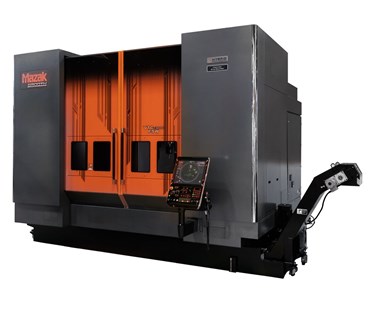Mazak's VTC-300C FSW Joins, Machines Alloys with Low Melting Points
A part of Mazak’s family of hybrid multitasking machining centers, the VTC-300C FSW combines milling capabilities with friction stir welding (FSW).
Share





A part of Mazak’s family of hybrid multitasking machining centers, the VTC-300C FSW combines milling capabilities with friction stir welding (FSW). With a full traveling-column design, automatic toolchanger and 40-taper spindle in addition to the FSW package, this machine helps shops achieve reduced lead times and greater part accuracy while enabling novel methods for processing parts with stronger welds, the company says.

The machine’s FSW package uses a process that involves frictional heat and forging pressure to create full-penetration, defect-free welded joints said to be stronger than those made with conventional methods. Using a solid-state joining process with a non-consumable tool pin, the Mazak FSW head joins two metal plates without melting the workpiece. Commonly considered a forging process, FSW is described as well-suited for joining alloys with low melting points, including aluminum, copper and brass, among others.
The new welding technology complements the existing VTC-300C machine platform, which delivers a standard 15,000-rpm, 30-hp, 40-taper spindle capable of handling a variety of metalcutting applications. Additionally, the machine and way cover designs have been enhanced to provide 1,574-ipm rapid feed rates on all axes. The fixed 78.74" × 30" table provides process flexibility for a range of applications, while an optional center partition can divide the work envelope into two separate work zones to allow the machine to be in cycle in one area while an operator loads, unloads or sets up a part in the other. The machine’s X-, Y- and Z-axis travels measure 65.35", 30" and 25.6", respectively.
The VTC-300C FSW also features Mazak’s Mazatrol SmoothG CNC, which is designed to ease programming for highly complex parts. A large, 19" touchscreen display presents all of the critical machine data within a single page view, while the tilt control panel allows for optimum positioning based on operator height.
Related Content
-
Fryer Milling Machine Provides Fast Setup, Simple Programming
The MB-R toolroom bed mill is reportedly capable of single- or multi-part production with a 0.0002" accuracy.
-
Tsugami Lathe, Vertical Machining Center Boost Machining Efficiency
IMTS 2024: Tsugami America showcases a multifunction sliding headstock lathe with a B-axis tool spindle, as well as a universal vertical machining center for rapid facing, drilling and tapping.
-
DN Solutions' VMC Provides Diverse Five-Axis Machining
The company’s DVF Series comprises compact five-axis CNC machines that are designed for diverse five-sided or simultaneous five-axis applications.

















.jpg;maxWidth=300;quality=90)


